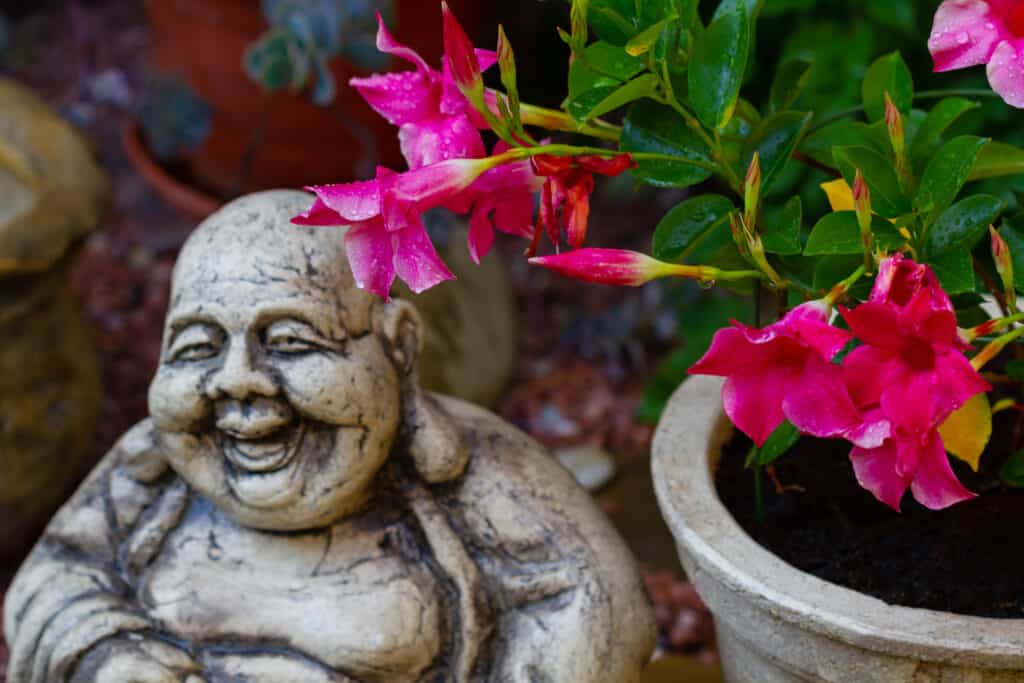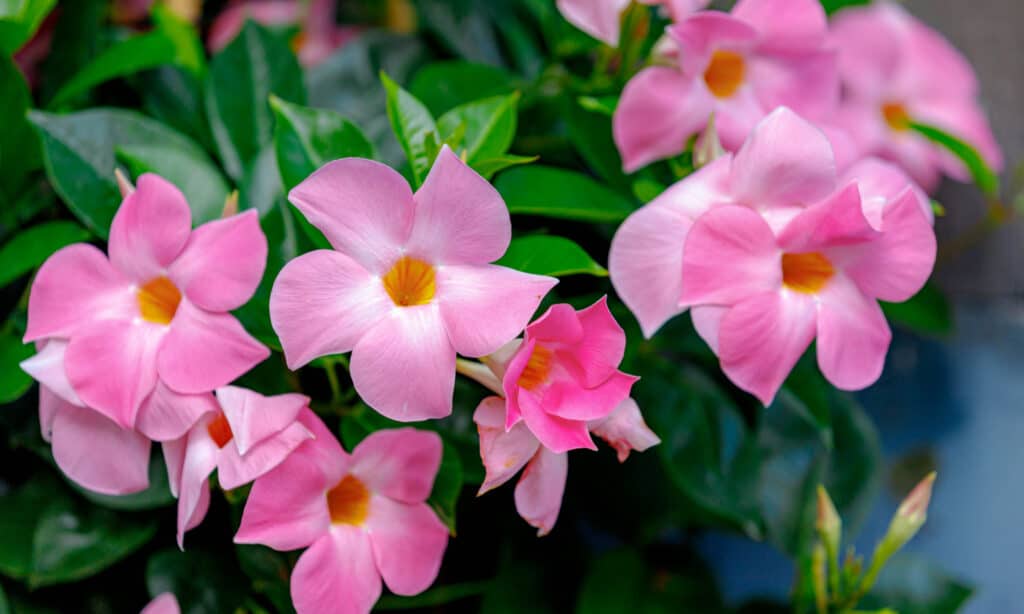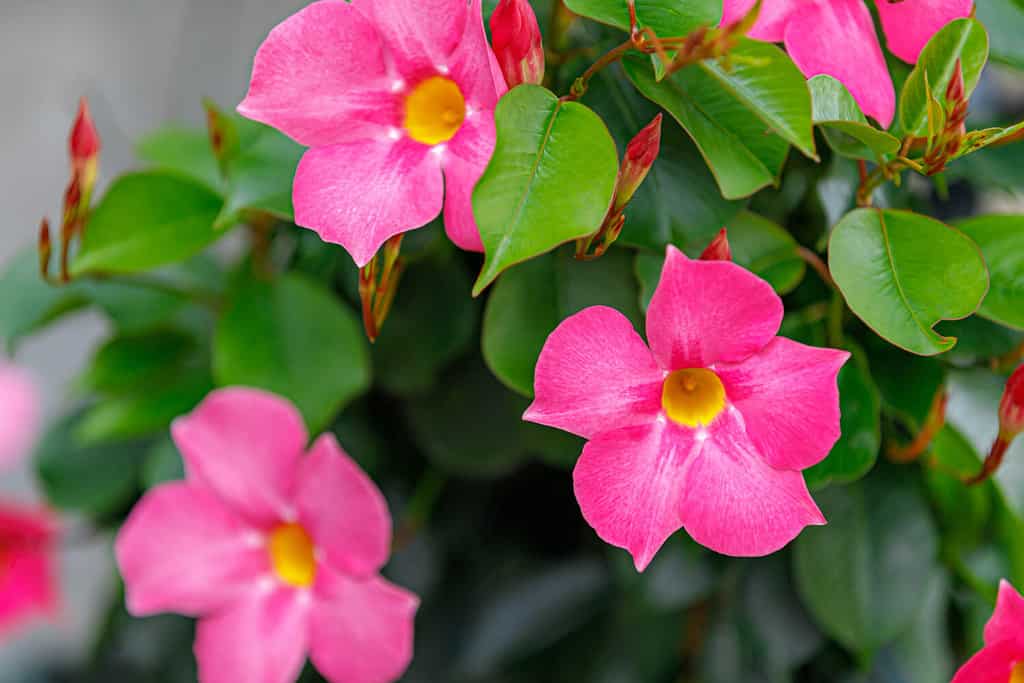Nothing makes a garden pop like mandevilla flowers. With their glossy leaves and striking, trumpet-shaped flowers, they have become a popular garden staple. Native to Brazil, mandevilla (Mandevilla splendens) flowers can be lush tones of red, pink, yellow, or white. Aside from their stunning beauty, their popularity is due to their many additional attributes. Mandevilla is a prolific bloomer, fast-growing, disease- and pest-resistant, and low maintenance. There is one caveat, however, to its low-maintenance status — it can’t survive winter temperatures in many areas without intervention. The good news is there are a few tricks to keeping mandevilla alive through the winter.
#1 Plant in Pots

Mandevilla likes to be warm and cozy in pots.
©Photo_Olivia/Shutterstock.com
Mandevilla roots like to stay cozy and warm, according to Gardening with Mother Evelyn. Even if you live in an area that rarely sees frost, this tropical plant will suffer if planted in the ground. If planted in a large pot in April, and placed in an area with at least a half day of direct sunlight, Mandevilla varieties like Dipladenia Red Riding Hood, Scarlett Pimpernel, or White Faire Lady will bloom year round. While they may survive the winter planted in the ground in areas with hardiness zones of 10 or higher, they will not bloom all year. They are also likely to take a while to recover and come back into bloom.
For those growing mandevilla in areas where winter temperatures stay below 50 degrees Fahrenheit for extended periods, planting your mandevilla in a pot is a must. These tropical plants will die if left outside in freezing temperatures. If you must plant mandevillas in the ground outside where temperatures drop below 50 degrees Fahrenheit, they will behave as annuals. You would simply need to purchase new plants each spring.
Vining varieties of mandevilla thrive when provided with a trellis or trained to adorn an awning. Shrubbier varieties planted in hanging pots embellish any outdoor space. Whether wrapped around your patio awning or hanging from above, your mandevilla vines will need to be trimmed down dramatically in order to survive the winter.
Enter your zip code on the USDA’s Plant Hardiness Zone Map to discover which zone you live in!
#2 Trim Mandevilla Before Winter

A mandevilla can live up to 20 years.
©pixel creator/Shutterstock.com
For locations that don’t get cold winters, mandevillas won’t need to be trimmed down substantially before winter sets in. Remember, though, that mandevillas flower on new growth, so a little trim in the fall allows the plant to reset and flourish.
Most areas around the United States, however, experience winter temperatures that will kill tropical plants. Gardeners in hardiness zones below 10 will need to treat their mandevillas to a substantial trim. Ron Finley, the self-described “Gangster Gardener,” recommends that cold-weather residents prune their mandevilla in early fall before temperatures drop below freezing. The whole plant should be pruned back to just a few inches above the soil. Keeping the mandevilla compact allows it to more easily recover in the spring and produce new growth that gives you those signature flowers that attract people, bees, and hummingbirds alike.
Don’t worry if you notice a milky sap appear when cutting your mandevilla vines. This is a completely natural reaction and won’t harm the plant. Of course, if your mandevilla also happens to be your roommate and lives as a houseplant all year, trimming beyond what fits in your space is not necessary.
#3 Plant in a Sunny Location

Mandevilla can grow six to eight feet or more in a single season.
©Wut_Moppie/Shutterstock.com
Keeping your mandevilla alive in winter when it is planted in the ground is only possible in a few select locations in the United States. According to the USDA hardiness map, there are 13 planting zones. Of those, only zones 10-13 stay warm enough for mandevilla to survive all year outside. These zones are found in Florida, Southern California, the southernmost tip of Texas, Hawaii, and Puerto Rico.
If you live in one of those zones, while you have the option to leave your mandevilla outdoors over the winter, where you choose to place the plant will influence whether it thrives or not. Plant in a warm location either in a pot or in the ground. Mandevillas are frost and cold-sensitive in winter temperatures, so plant in a southern exposure or protected area near your home. A spot with morning sun and afternoon shade is optimal.
Mandevillas are prone to root rot. Take care not to plant them beneath a rain gutter where the soil stays moist in winter. Ensure you plant them in soil with good drainage by mixing it with 20 percent pumice. You can also plant the mandevilla about two inches higher than the ground so water doesn’t pool around the roots.
#4 Bring Mandevilla Plants Inside the House

Like most tropical plants, mandevillas can’t survive freezing temperatures. To keep your mandevillas alive in the winter, they must be brought inside in cold locations.
©Wut_Moppie/Shutterstock.com
For the majority of the country, keeping mandevilla alive in winter requires bringing the tropical plant indoors before temperatures drop below 40 degrees Fahrenheit. Trim the vines down to a length appropriate for your home. Find a bright, sunny window to rehome your mandevilla for the winter. Before bringing indoors, ensure the plant is free of pests. Spraying the leaves with a mix of water and neem oil should do the trick.
Inside your home is likely much drier than outdoors, so take care to not let the soil dry out. There won’t be much growth during the winter, so your mandevilla shouldn’t require too much water either. Start adding some fertilizer once a month starting in February after another light pruning. By March or April, your mandevilla will be ready to shine.
#5 Let Your Mandevilla Overwinter in the Garage

Mandevilla can survive the winter in a garage if allowed to go dormant.
©Nahhana/Shutterstock.com
Another option for keeping your mandevilla alive in winter is to allow it to go dormant. Keep your plant outside until it starts to get cold. Cut the vines back hard, to no more than 12 inches above the soil. Then, move the mandevilla to a cool garage or basement. The temperature should stay above freezing all winter. Somewhere around 50 degrees Fahrenheit is ideal for dormancy. In this scenario, you are essentially leaving the plant alone other than occasionally giving it water. Just be sure it doesn’t dry out completely.
You can give it a bit of a head start by bringing it inside the house when spring is near to let it begin coming back to life. Then place it back in its sunny spot outside and enjoy the magic of this wonderful tropical flower. With a lot of love, your mandevilla can give you up to 20 years of enjoyment. Good luck!
Thank you for reading! Have some feedback for us? Contact the AZ Animals editorial team.








